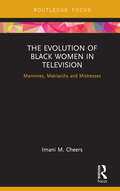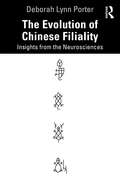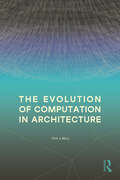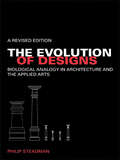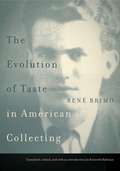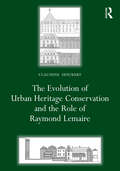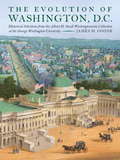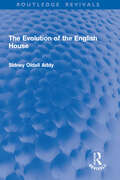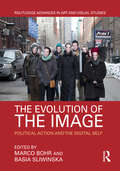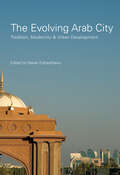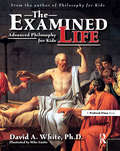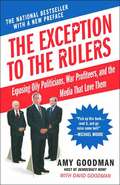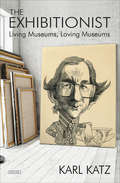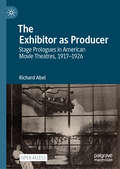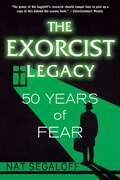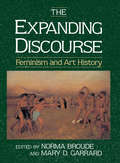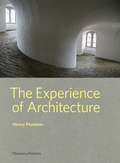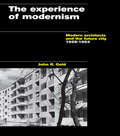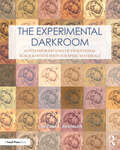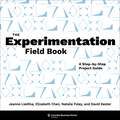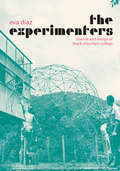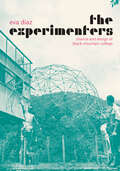- Table View
- List View
The Evolution of Black Women in Television: Mammies, Matriarchs and Mistresses (Routledge Focus on Television Studies)
by Imani M. CheersThis book seeks to interrogate the representation of Black women in television. Cheers explores how the increase of Black women in media ownership and creative executive roles (producers, showrunners, directors and writers) in the last 30 years affected the fundamental cultural shift in Black women’s representation on television, which in turn parallels the political, social, economic and cultural advancements of Black women in America from 1950 to 2016. She also examines Black women as a diverse television audience, discussing how they interact and respond to the constantly evolving television representation of their image and likeness, looking specifically at how social media is used as a tool of audience engagement.
The Evolution of Chinese Filiality: Insights from the Neurosciences
by Deborah Lynn PorterThis unique book brings a fresh interdisciplinary approach to the analysis of ancient Chinese history, creating a historical model for the emergence of cultural mainstays by applying recent dramatic findings in the fields of neuroscience and cultural evolution. The centrality in Chinese culture of a deep reverence for the lives of preceding generations, filial piety, is conventionally attributed to Confucius (551-479 B.C.), who viewed hierarchical family relations as foundational for social order. Here, Porter argues that Confucian conceptions of filiality themselves evolved from a systemized set of behaviors and thoughts, a mental structure, which descended from a specific Neolithic mindset, and that this psychological structure was contoured by particular emotional conditions experienced by China’s earliest farmers. Using case study analysis from Neolithic sky observers to the dynastic cultures of the Shang and Western Zhou, the book shows how filial piety evolved as a structure of feeling, a legacy of a cultural predisposition toward particular moods and emotions that were inherited from the ancestral past. Porter also brings new urgency to the topic of ecological grief, linking the distress central to the evolution of the filial structure to its catalyst in an environmental crisis. With a blended multidisciplinary approach combining social neuroscience, cultural evolution, cognitive archaeology, and historical analysis, this book is ideal for students and researchers in neuropsychology, religion, and Chinese culture and history.
The Evolution of Computation in Architecture
by Michael Fox Bradley BellThis book is the first comprehensive overview of the pioneering works, events, and people that contributed to the paradigm shift defined by computation in architecture.Only recently has computation fostered profound new ways of designing, fabricating, constructing, and thinking about architecture. While the profession sits at the end of the beginning of this historically transformative shift, it is now possible to look back upon the rapidly maturing landscape of projects, influencers, and tools that have finally begun to catch up with the visionary thinking of the past. Readers are guided through the fascinating and fast-paced historical timeline of the development of computation in architecture. Beginning with an account of the pioneering futuristic thinkers, the authors then guide the reader through the birth of computation, the appropriation of tools and the impact of experimentation on the profession, leading into the legitimacy of research and how paradigms have been expanded. The examples and influences are presented in a way that they can be understood and built upon.This book is a must-read for students of computation in architecture as well as researchers and practicing architects thinking about how the tools we use and the ways we design our buildings and environments with them can truly impact our lives.
The Evolution of Designs: Biological Analogy in Architecture and the Applied Arts
by Philip SteadmanThis book tells the history of the many analogies that have been made between the evolution of organisms and the human production of artefacts, especially buildings. It examines the effects of these analogies on architectural and design theory and considers how recent biological thinking has relevance for design. Architects and designers have looked to biology for inspiration since the early 19th century. They have sought not just to imitate the forms of plants and animals, but to find methods in design analogous to the processes of growth and evolution in nature. This new revised edition of this classic work adds an extended Afterword covering recent developments such as the introduction of computer methods in design in the 1980s and ‘90s, which have made possible a new kind of ‘biomorphic’ architecture through ‘genetic algorithms’ and other programming techniques.
The Evolution of Taste in American Collecting
by Kenneth Haltman René BrimoThe Evolution of Taste in American Collecting is a new critical translation of René Brimo’s classic study of eighteenth- and nineteenth-century patronage and art collecting in the United States. Originally published in French in 1938, Brimo’s foundational text is a detailed examination of collecting in America from colonial times to the end of World War I, when American collectors came to dominate the European art market. This work helped shape the then-fledgling field of American art history by explaining larger cultural transformations as manifested in the collecting habits of American elites. It remains the most substantive account of the history of collecting in the United States.In his introduction, Kenneth Haltman provides a biographical study of the author and his social and intellectual milieu in France and the United States. He also explores how Brimo’s work formed a turning point and initiated a new area of academic study: the history of art collecting.Making accessible a text that has until now only been available in French, Haltman’s elegant translation of The Evolution of Taste in American Collecting sheds new critical light on the essential work of this extraordinary but overlooked scholar.
The Evolution of Taste in American Collecting
by René BrimoThe Evolution of Taste in American Collecting is a new critical translation of René Brimo’s classic study of eighteenth- and nineteenth-century patronage and art collecting in the United States. Originally published in French in 1938, Brimo’s foundational text is a detailed examination of collecting in America from colonial times to the end of World War I, when American collectors came to dominate the European art market. This work helped shape the then-fledgling field of American art history by explaining larger cultural transformations as manifested in the collecting habits of American elites. It remains the most substantive account of the history of collecting in the United States.In his introduction, Kenneth Haltman provides a biographical study of the author and his social and intellectual milieu in France and the United States. He also explores how Brimo’s work formed a turning point and initiated a new area of academic study: the history of art collecting.Making accessible a text that has until now only been available in French, Haltman’s elegant translation of The Evolution of Taste in American Collecting sheds new critical light on the essential work of this extraordinary but overlooked scholar.
The Evolution of Urban Form: Typology for Planners and Architects
by Brenda Case ScheerWhy are so many of our urban environments so resistant to change? The author tackles this question in her comprehensive guide for planners, designers, and students concerned with how cities take shape. This book provides a fundamental understanding of how physical environments are created, changed, and transformed through ordinary processes over time. Most of the built environment adheres to a few physical patterns, or types, that occur over and over. Planners and architects, consciously and unconsciously, refer to building types as they work through urban design problems and regulations. Suitable for professional planners, architects, urban designers, and students, This book includes practical examples of how typology is critical to analytical, design, and regulatory situations.
The Evolution of Urban Heritage Conservation and the Role of Raymond Lemaire (ISSN)
by Claudine HoubartThe 1960s and 1970s saw a marked change in the approach to built heritage conservation. From a focus on the preservation of individual buildings, attention turned to the conservation, regeneration, and reuse of entire historic districts. A key player in this process was the Belgian art and architecture historian Raymond Lemaire (1921–1997), yet beyond those in conservation circles few people know of his work and influence or even recognize his name.In this book, Claudine Houbart traces how the change came about and the role played by Lemaire. She describes his work and influence and in so doing provides a history of urban conservation over the last four decades of the twentieth century and beyond. The first chapter summarizes Lemaire’s background from his training during the Second World War and his work as a Monuments Man immediately after the war, to his role in the drafting of the Venice Charter and his appointment as Secretary General of ICOMOS (International Council on Monuments and Sites). The next chapter describes the rehabilitation of Great Beguinage in Louvain. Now a UNESCO World Heritage Site, the project was directed by Lemaire and is a perfect example of the restoration of an entire district. The following chapter provides case studies of his work in Brussels, demonstrating his methodology in action. The final chapter discusses the transposition of the model of the historic city to urban projects and summarizes Lemaire’s influence on heritage conservation today, particularly integrated conservation. His participation in drafting key conservation documents sponsored by the Council of Europe, UNESCO and ICOMOS, and his desire to revise the Venice Charter are discussed. The book’s conclusion reflects on what has gone before, ending aptly with Lemaire’s own words ‘the past, properly understood, is one of the references for judging the value of today and tomorrow’.
The Evolution of Washington, DC
by Sandra Day O'Connor John Wetenhall James M. Goode Laura W. Bush Steven KnappThe Evolution of Washington, DC is a striking volume featuring select pieces of the extraordinary collection of Washingtoniana donated by Albert H. Small to the George Washington University in 2011. It showcases treasures such as an 1860 lithograph of the equestrian statue of Andrew Jackson in front of the White House and a contemporary print of old Potomac River steamboats. Other unique pieces include early designs for the White House, the Capitol, and the Washington Monument as well as presidential portraits and Civil War memorabilia. Each object--from architectural plans and topographical maps to letters and advertisements--tells a fascinating story, and together they illustrate the history of our nation's capital and indeed our nation itself.
The Evolution of the English House (Routledge Revivals)
by Sidney Oldall AddyThe Evolution of the English House (1933) discusses the popular and native art in domestic English architecture, tracing the changes over the years. The focus is on plain wattled huts and combinations of dwelling-house and cattle-stall, as well as the great villas and picturesque timber houses of the wealthy. In this way the author establishes how the masses of the English people lived in past times.
The Evolution of the Image: Political Action and the Digital Self (Routledge Advances in Art and Visual Studies)
by Basia Sliwinska Marco BohrThis volume addresses the evolution of the visual in digital communities, offering a multidisciplinary discussion of the ways in which images are circulated in digital communities, the meanings that are attached to them and the implications they have for notions of identity, memory, gender, cultural belonging and political action. Contributors focus on the political efficacy of the image in digital communities, as well as the representation of the digital self in order to offer a fresh perspective on the role of digital images in the creation and promotion of new forms of resistance, agency and identity within visual cultures.
The Evolving Arab City: Tradition, Modernity and Urban Development (Planning, History and Environment Series)
by Yasser ElsheshtawyToday cities of the Arab world are subject to many of the same problems as other world cities, yet too often they are ignored in studies of urbanisation. This collection reveals the contrasts and similarities between older, traditional Arab cities and the newer oil-stimulated cities of the Gulf in their search for development and a place in the world order. The eight cities which form the core of the book – Rabat, Amman, Beirut, Kuwait, Manama, Doha, Abu Dhabi and Riyadh – provide a unique insight into today’s Middle Eastern city. Winner of The International Planning History Society (IPHS) Book Prize.
The Examined Life: Advanced Philosophy for Kids (Grades 7-12)
by David A. WhiteIn this book, the follow-up to the best-sellingPhilosophy for Kids, Dr. David White delves deeper into the philosophical questions kids (and adults) care about deeply. Through vibrant discussions and debate, the book offers ways teachers can help students grapple with age-old questions about the nature of friendship (Aristotle), time (Augustine), knowledge (Plato), existence of God (Aquinas), perception (Berkeley), freedom and society (Rousseau), and many more.The book is divided into three sections. Part 1 presents primary source readings that will encourage discussion and debate; Part 2 offers easy-to-use activities that focus on the direct application of philosophy to areas such as critical thinking, language, and the arts; and Part 3 offers a unique perspective just for teachers—a philosophical look at how teachers can become more reflective philosophers themselves. This is an excellent teachers' handbook for using advanced philosophy in the classroom.Grades 7-12
The Exception to the Rulers: Exposing Oily Politicians, War Profiteers, and the Media That Love Them
by Amy Goodman David GoodmanHer comments turned Charlie Rose red in the face. Bill Clinton called her 'hostile, combative, and even disrespectful.' Newt Gingrich said to her, 'You're the kind of reporter I warned my mother about.' Meet Amy Goodman, award-winning journalist and host of the daily hour-long talk show that is a beacon for passionate, critical, and hard-hitting news. On subjects ranging from the deceptions of the George H. W. Bush administration to the corruption of media monopolies and corporate influence over the government, Amy Goodman attacks and exposes the lies and hypocrisy that put democracy at risk. Goodman has traveled the world reporting and speaking out in defense of human rights and offers no apologies for her advocacy. At lectures, rallies, and other public appearances, thousands turn out to hear her speak the truth. Now, in her first book, she offers her no-holds-barred perspective on world events.
The Exhibitionist: Living Museums, Loving Museums
by Karl KatzThe renowned curator gives a personal tour of his journey from archeology to the Met, the Jewish Museum, and helping found the Israel Museum. In The Exhibitionist, museum director Karl Katz discusses his tireless, impassioned work spanning six decades and numerous countries. As a young man, Karl traveled to the newly-formed state of Israel to pursue archaeology, only to be thrust into the role of directing the Bezalel National Art Museum in Jerusalem. From that early trial by fire to his many leadership roles at the Museum of Tolerance, the International Center of Photography, the Metropolitan Museum of Art, and elsewhere, Katz found innovative ways to make museums inviting, educational, living, and vibrant. A book for lovers of history and art criticism, as well as collectors, curators, administrators, and students, The Exhibitionist is filled with a wide range of discussions both cultural and personal. Katz discusses the exhibits, the discoveries, and the incredible people he worked with along the way, from his mentor Teddy Kollek, the mayor of Jerusalem and founder of the Israel Museum, to Jaqueline Kennedy Onassis and Broadway showman Billy Rose.
The Exhibitor as Producer: Stage Prologues in American Movie Theatres, 1917-1926
by Richard AbelThis open access book seeks answers to a series of questions about the little studied subject of prologues or theatrical presentations in American movie theaters from the late 1910s to the mid-1920s. How did prologues emerge out of prior practices? Who were the exhibitors most involved? What characteristics would come to define prologues? How widespread did they become not only in metropolitan palace cinemas but also in movie theaters in mid-sized cities and even small towns? If they generally created an atmosphere that complimented or harmonized with the feature films, could they also be what at the time was called “contrastive“? Who were the performers in these theatrical presentations? Were prologues ever described, in ads and audience responses, as a program’s main attraction and to what effect? The book comprises five chapters and up to a hundred photographs of prologue stage settings. Moreover, supplementing each chapter is one or more relevant trade press documents. Overall, the chapters construct a set of practices and typologies that came to define the theatrical presentations that typically preceded the feature films. They also advance this argument: the variety format of combined stage and screen performance in movie theaters has a longer and unexpectedly revealing history than usually assumed. In short, an exhibitor would have a certain degree of creativity in his/her programming, which in turn could strongly impact an audience’s movie-going experience.
The Exorcist Legacy: 50 Years of Fear
by Nat SegaloffThe definitive, fascinating story of the scariest film ever made and its enduring impact in Hollywood and beyond—from the director&’s biographer comes a must-read for horror fans and cinema buffs, just in time for the movie&’s 50th anniversary and the release of the first movie in a new Exorcist trilogy. Includes a foreword by John Russo, author and cowriter of the seminal horror film Night of the Living Dead. On December 26, 1973, The Exorcist was released. Within days it had become legend. Moviegoers braved hours-long lines in winter weather to see it. Some audience members famously fainted or vomited. Half a century later, the movie that both inspired and transcends the modern horror genre has lost none of its power to terrify and unsettle. The Exorcist Legacy reveals the complete story of this cultural phenomenon, from the real-life exorcism in 1949 Maryland that inspired William Peter Blatty&’s bestselling novel on which the movie is based, to its many sequels, prequels, TV series, and homages. Nat Segaloff, biographer of the film&’s director, William Friedkin, draws on original interviews with cast, crew, and participants as well as revelations from personal papers to present an intriguing and surprising new view of the making of the movie, and its aftermath. Segaloff also examines as never before the keys to the movie&’s enduring appeal. Friedkin and Blatty&’s goal was far more ambitious than making a scary movie; they aimed to make people &“think about the concept of good and evil.&” The Exorcist succeeds, and then some, not just by creating on-screen scares, but by challenging viewers&’ deepest personal beliefs—and fears.
The Expanding Discourse: Feminism And Art History
by Norma BroudeA sequel to the pioneering volume, Feminism and Art History: Questioning the Litany, published in 1982, The Expanding Discourse contains 29 essays on artists and issues from the Renaissance to the present, representing some of the best feminist art-historical writing of the past decade. Chronologically arranged, the essays demonstrate the abundance, diversity, and main conceptual trends in recent feminist scholarship.
The Experience of Architecture
by Henry PlummerA thought-provoking consideration of how architecture, from a doorknob to a city plan, can influence human behavior How does the experience of turning a door handle, opening a door from one space into another, affect us? It is no wonder that the door, one of the most elemental architectural forms, has such metaphorical richness. But even on a purely physical human level, the cold touch of a brass handle or the swish of a sliding screen gives rise to an emotional reaction, sometimes modest, occasionally profound. This book aims to understand how these everyday acts are influenced by architectural form, a concept that is vital for all architects to grasp. It considers how specifically built elements and volumes, taken from a wide array of buildings and settings around the world, can affect our powers of decision. From hand-carved stairs in Greek villages to free-floating catwalks, from the elegant processional steps of Renaissance Italy to Frank Lloyd Wright's masterly manipulation of form, all provide very different experiences of stepping from one level to the next, and all affect our experience of that space. Seamlessly integrating text and image, each chapter focuses on a different aspect of our daily interactions with architecture, looking at stairs, floors and paths, moving interior spaces, perception and perspective, transparency and the relationship between a building and its setting. This book is not just for architects and designers engaged in the production of space, but for all those who seek a richer understanding of their place in the built world.
The Experience of Modernism: Modern Architects and the Future City, 1928-53
by John R. GoldMaking extensive use of information gained from in-depth interviews with architects active in the period between 1928-1953, the author provides a sympathetic understanding of the Modern Movement's architectural role in reshaping the fabric and structure of British metropolitan cities in the post-war period and traces the links between the experience of British modernists and the wider international modern movement.
The Experimental Darkroom: Contemporary Uses of Traditional Black & White Photographic Materials (Contemporary Practices in Alternative Process Photography)
by Christina Z AndersonThe Experimental Darkroom is a book focused on traditional black & white photographic materials—darkroom chemistry and silver gelatin paper—now used in many non-traditional ways. The book starts with a comprehensive digital negatives chapter. Topics are divided into five sections: cameraless experimentation, camera experimentation, printing experimentation, finished print experimentation, and a section highlighting contemporary photographers who use these approaches today. Each process under discussion is accompanied by photographic examples and a step-by-step method written in a “Just the facts, ma’am” style. Topics included are: Photograms and clichés verre Lumen prints Chemigrams Pinhole and zoneplate Holgas Chromo Liquid emulsion and modern tintype Lith printing Sabattier Mordançage Bleaching and bleachout Toning, traditional to experimental Applied color and abrasion tone Encaustic, photomontage, and collage Bromoil The Experimental Darkroom encourages taking risks and having fun. Over 400 images and 71 artists are included in its 276 pages. The outcome will be an expansion of creative options for the silver gelatin print. The options are engaging and now more accessible with digital negatives. Images are no longer solely captured in camera or on analog film. The darkroom is no longer always dark. The print is no longer a pristine and accurate rendition of what the camera sees. Photographers are pushing the boundaries of black & white photographic practice. It is an exciting time to get into the darkroom and play!
The Experimentation Field Book: A Step-by-Step Project Guide
by Jeanne Liedtka Elizabeth Chen Natalie Foley David KesterExperimentation is an essential part of innovation. It is the link between generating new ideas and putting them into practice. We are constantly experimenting in our daily lives, and organizations place great value on testing new products, services, and strategies. Yet there is a shortage of actionable guidance on how to design and execute high-quality experiments for practical purposes.This book is a hands-on manual for crafting and conducting useful experiments in real-life settings. It guides readers from any background or discipline through the fundamentals of identifying testable ideas, selecting an evidence base, prototyping, and testing, building users’ skill sets and channeling their creativity through an interactive, exercise-oriented format. The book details a step-by-step framework, with user-friendly instructions and a case study illustrating the process at work at each step, as well as templates for readers to customize in their own projects. It draws on design thinking as well as other practical business approaches. From the classroom to the practice world, The Experimentation Field Book is a vital tool kit for all problem solvers and innovators seeking to address today’s pressing challenges.
The Experimenters: Chance and Design at Black Mountain College
by Eva DíazIn the years immediately following World War II, Black Mountain College, an unaccredited school in rural Appalachia, became a vital hub of cultural innovation. Practically every major artistic figure of the mid-twentieth century spent some time there: Merce Cunningham, Ray Johnson, Franz Kline, Willem and Elaine de Kooning, Robert Motherwell, Robert Rauschenberg, Dorothea Rockburne, Aaron Siskind, Cy Twombly--the list goes on and on. Yet scholars have tended to view these artists’ time at the College as little more than prologue, a step on their way to greatness. With The Experimenters, Eva Díaz reveals the importance of Black Mountain College--and especially of three key teachers, Josef Albers, John Cage, and R. Buckminster Fuller--to be much greater than that. Díaz’s focus is on experimentation. Albers, Cage, and Fuller, she shows, taught new models of art making that favored testing procedures rather than personal expression. These methodologies represented incipient directions for postwar art practice, elements of which would be sampled, and often wholly adopted, by Black Mountain students and subsequent practitioners. The resulting works, which interrelate art and life in a way that imbues these projects with crucial relevance, not only reconfigured the relationships among chance, order, and design--they helped redefine what artistic practice was, and could be, for future generations. Offering a bold, compelling new angle on some of the most widely studied creative figures of modern times, The Experimenters does nothing less than rewrite the story of art in the mid-twentieth century.
The Experimenters: Chance and Design at Black Mountain College
by Eva DíazIn the years immediately following World War II, Black Mountain College, an unaccredited school in rural Appalachia, became a vital hub of cultural innovation. Practically every major artistic figure of the mid-twentieth century spent some time there: Merce Cunningham, Ray Johnson, Franz Kline, Willem and Elaine de Kooning, Robert Motherwell, Robert Rauschenberg, Dorothea Rockburne, Aaron Siskind, Cy Twombly—the list goes on and on. Yet scholars have tended to view these artists’ time at the College as little more than prologue, a step on their way to greatness. With The Experimenters, Eva Díaz reveals the importance of Black Mountain College—and especially of three key teachers, Josef Albers, John Cage, and R. Buckminster Fuller—to be much greater than that. Díaz’s focus is on experimentation. Albers, Cage, and Fuller, she shows, taught new models of art making that favored testing procedures rather than personal expression. These methodologies represented incipient directions for postwar art practice, elements of which would be sampled, and often wholly adopted, by Black Mountain students and subsequent practitioners. The resulting works, which interrelate art and life in a way that imbues these projects with crucial relevance, not only reconfigured the relationships among chance, order, and design—they helped redefine what artistic practice was, and could be, for future generations. Offering a bold, compelling new angle on some of the most widely studied creative figures of modern times, The Experimenters does nothing less than rewrite the story of art in the mid-twentieth century.
The Expert Teacher of English
by Andrew GoodwynThe Expert Teacher of English is for all passionate teachers – both novice and expert - who aspire to become outstanding professionals. It considers what we mean by ‘expert’ and ‘expertise’, explores concepts that are vital to understanding what expertise in teaching is ‘for’, and discusses the characteristics of excellent teaching. As increasing attention is being paid to the concept of the professional who can model excellent teaching and mentor and develop others, it provides a critical analysis of The Advanced Skills Teacher and the Excellent Teacher, as well as the Chartered Teacher in Scotland and the ‘highly accomplished teacher’ in the US. Ideas and issues considered include: The nature of English as a school subject What it means to be part of a profession Curriculum design, lesson planning and assessment Opportunities for technologies in the English classroom Working collaboratively with colleagues, mentoring and observation Continuing professional development and research Drawing on the views, ideas and experiences of a group of skilful teachers, The Expert Teacher of English aims to stimulate personal and professional development, help you reflect on the concept of expertise, and support you as you develop as a highly accomplished teacher.
